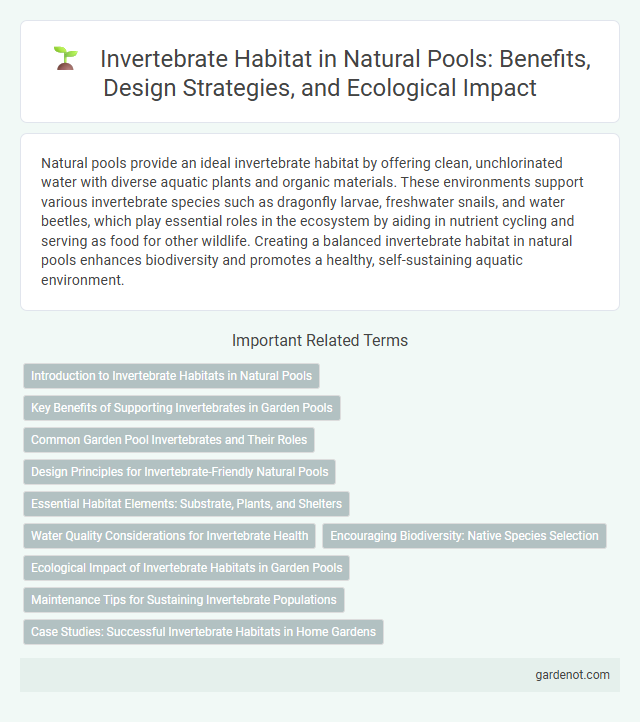Natural pools provide an ideal invertebrate habitat by offering clean, unchlorinated water with diverse aquatic plants and organic materials. These environments support various invertebrate species such as dragonfly larvae, freshwater snails, and water beetles, which play essential roles in the ecosystem by aiding in nutrient cycling and serving as food for other wildlife. Creating a balanced invertebrate habitat in natural pools enhances biodiversity and promotes a healthy, self-sustaining aquatic environment.
Introduction to Invertebrate Habitats in Natural Pools
Invertebrate habitats in natural pools provide essential ecological niches that support biodiversity and water quality. These habitats include submerged vegetation, sediment layers, and organic debris, offering shelter and breeding grounds for various insect larvae, crustaceans, and mollusks. Understanding these microhabitats is crucial for maintaining the ecological balance and promoting natural filtration processes in sustainable pool design.
Key Benefits of Supporting Invertebrates in Garden Pools
Supporting invertebrates in garden natural pools enhances biodiversity, promoting a balanced aquatic ecosystem essential for water purification and nutrient cycling. Invertebrates serve as a critical food source for amphibians and birds, thereby fostering a thriving habitat that sustains wildlife. Their presence helps control algae and pest populations naturally, reducing the need for chemical interventions.
Common Garden Pool Invertebrates and Their Roles
Common garden pool invertebrates such as water beetles, pond snails, and freshwater shrimp play vital roles in maintaining a balanced ecosystem by contributing to nutrient cycling and organic matter decomposition. These invertebrates also serve as a crucial food source for amphibians and aquatic birds, supporting biodiversity within natural pools. Their presence indicates good water quality and enhances the ecological stability of garden pond habitats.
Design Principles for Invertebrate-Friendly Natural Pools
Design principles for invertebrate-friendly natural pools emphasize creating diverse microhabitats such as shallow edges, submerged plants, and varied substrates to support a wide range of aquatic invertebrates. Incorporating native vegetation and avoiding chemical treatments ensures water quality that sustains invertebrate populations crucial for ecosystem balance. Structured zones with different depths and organic matter accumulation promote breeding and feeding opportunities, enhancing biodiversity in natural pool environments.
Essential Habitat Elements: Substrate, Plants, and Shelters
Natural pools provide essential habitat elements such as diverse substrates, aquatic plants, and shelters that support invertebrate biodiversity. Varied substrates like gravel, sand, and organic detritus create surfaces for invertebrates to attach, forage, and reproduce, while submerged and emergent plants offer food resources and protective cover. Shelters formed by stones, logs, and plant roots enhance survival by providing refuge from predators and environmental stressors.
Water Quality Considerations for Invertebrate Health
Maintaining optimal water quality is essential for supporting diverse invertebrate habitats in natural pools, as these organisms are highly sensitive to parameters such as pH, dissolved oxygen, and pollutant levels. Low concentrations of nitrates and phosphates help prevent algal blooms that can deplete oxygen and disrupt the ecological balance necessary for invertebrate survival. Regular monitoring of water temperature and clarity ensures a stable environment that fosters biodiversity and promotes healthy invertebrate populations.
Encouraging Biodiversity: Native Species Selection
Selecting native plant species for a natural pool creates a balanced invertebrate habitat by providing essential food sources and shelter, which boosts local biodiversity. Native aquatic plants support a diverse range of invertebrates like dragonflies, water beetles, and snails that contribute to ecosystem health and natural water filtration. Encouraging these native species in natural pools enhances ecological stability, promotes biological control of pests, and fosters a resilient, self-sustaining aquatic environment.
Ecological Impact of Invertebrate Habitats in Garden Pools
Invertebrate habitats in garden pools play a crucial role in maintaining ecological balance by supporting biodiversity and facilitating nutrient cycling. These microhabitats provide breeding grounds and food sources for various species, contributing to pest control and water purification. Enhancing invertebrate diversity in natural pools promotes ecosystem resilience and helps sustain water quality.
Maintenance Tips for Sustaining Invertebrate Populations
Regular monitoring of water quality parameters such as pH, temperature, and nutrient levels is essential for maintaining a healthy invertebrate habitat within natural pools. Incorporating native aquatic plants provides shelter and breeding grounds, supporting diverse invertebrate populations and promoting ecosystem stability. Avoiding chemical pollutants and limiting disturbance during maintenance activities helps sustain the delicate balance of invertebrate communities critical for nutrient cycling and water purification.
Case Studies: Successful Invertebrate Habitats in Home Gardens
Case studies reveal that natural pools incorporating varied aquatic plants and microhabitats significantly boost invertebrate biodiversity in home gardens. Species such as dragonflies, damselflies, and freshwater shrimps thrive in these habitats due to clean water and abundant submerged vegetation. These successful models demonstrate how natural pool design can enhance local ecosystems, promoting ecological balance and pest control naturally.
Invertebrate habitat Infographic

 gardenot.com
gardenot.com